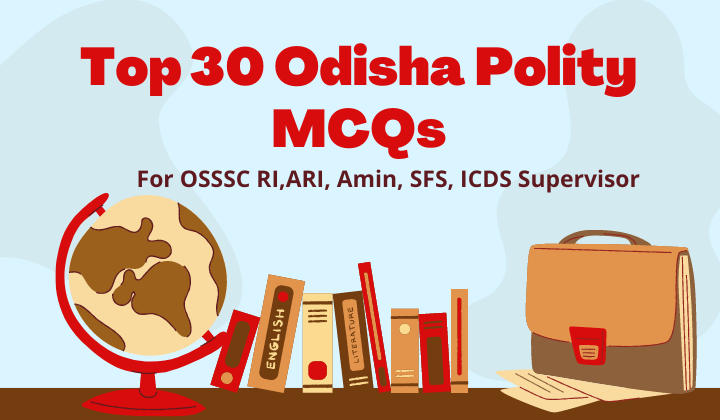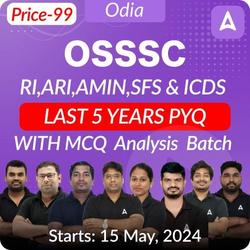As candidates prepare for OSSSC (Odisha Sub-ordinate Staff Selection Commission) examinations, including roles such as RI (Revenue Inspector), ARI (Assistant Revenue Inspector), Amin, SFS (Statistical Field Surveyor), and ICDS (Integrated Child Development Services) Supervisor, an understanding of Odisha’s polity becomes paramount. Encapsulating the essence of Odisha’s political landscape, here are 30 multiple-choice questions (MCQs) meticulously crafted to navigate aspirants through the labyrinth of Odisha’s governance structure. From constitutional provisions to administrative protocols, these questions offer a comprehensive glimpse into the foundational pillars of Odisha’s polity, empowering candidates to navigate the OSSSC examinations with confidence and proficiency. As they embark on their quest to serve the state with diligence and dedication, let these MCQs serve as guiding beacons, illuminating the path towards a deeper comprehension of Odisha’s polity and governance dynamics.
Top 30 Polity of Odisha MCQs For OSSSC RI,ARI, Amin, SFS, ICDS Supervisor
- When did Odisha become a separate province by the Government of British India?
A) 1936
B) 1947
C) 1950
D) 1962
Answer: A) 1936 - What was significant about Odisha’s separation as a province in 1936?
A) It was based on religious lines
B) It was based on linguistic lines
C) It was based on cultural lines
D) It was based on geographical lines
Answer: B) It was based on linguistic lines - Who was the first pre-Independence Leader of the Odisha Legislative Assembly?
A) Krushna Chandra Gajapati
B) Harekrushna Mahatab
C) Nandini Satpathy
D) Mukunda Prasad Das
Answer: A) Krushna Chandra Gajapati - What is the current strength of the Odisha Legislative Assembly?
A) 100 members
B) 120 members
C) 147 members
D) 200 members
Answer: C) 147 members - According to Article 169 of the Indian Constitution, what type of legislature does Odisha have?
A) Bicameral
B) Unicameral
C) Tricameral
D) Quadricameral
Answer: B) Unicameral - Who inaugurated the building of the Odisha Legislative Assembly?
A) Mahatma Gandhi
B) Jawaharlal Nehru
C) Sarvepalli Radhakrishnan
D) Biju Patnaik
Answer: C) Sarvepalli Radhakrishnan - What is the term of the Odisha Legislative Assembly?
A) 2 years
B) 3 years
C) 4 years
D) 5 years
Answer: D) 5 years - Who was the first post-Independence Leader of the Odisha Legislative Assembly?
A) Krushna Chandra Gajapati
B) Harekrushna Mahatab
C) Nandini Satpathy
D) Mukunda Prasad Das
Answer: B) Harekrushna Mahatab - What is the primary duty of the Odisha Legislative Assembly?
A) Judicial Review
B) Passing Bills
C) Executive Orders
D) Foreign Affairs
Answer: B) Passing Bills - Who presides over all the meetings of the Odisha Legislative Assembly?
A) Chief Minister
B) Governor
C) Speaker
D) Deputy Speaker
Answer: C) Speaker - What is the minimum age requirement to become a member of the Odisha Legislative Assembly?
A) 18 years
B) 21 years
C) 25 years
D) 30 years
Answer: C) 25 years - Which article of the Indian Constitution empowers the Odisha Legislative Assembly to have either Unicameral or Bicameral Legislature?
A) Article 169
B) Article 370
C) Article 356
D) Article 371
Answer: A) Article 169 - Who was the first post-Independence Speaker of the Odisha Legislative Assembly?
A) Mukunda Prasad Das
B) Nanda Kishore Das
C) Sarvepalli Radhakrishnan
D) Biju Patnaik
Answer: B) Nanda Kishore Das - What type of legislature does Odisha have?
A) Bicameral
B) Unicameral
C) Tricameral
D) Quadricameral
Answer: B) Unicameral - What is the role of the Odisha Legislative Assembly in framing laws?
A) Judicial Review
B) Enforcement
C) Passing Bills
D) Investigating Crimes
Answer: C) Passing Bills - Who is the Chief Executive head of Odisha state?
A) Chief Minister
B) Governor
C) President
D) Prime Minister
Answer: B) Governor - According to the Indian Constitution, who appoints the Governor of a state?
A) Prime Minister
B) Chief Minister
C) President
D) State Legislative Assembly
Answer: C) President - Who was the first post-Independence Governor of Odisha?
A) John Austin Hubback
B) Kailash Nath Katju
C) Chandulal Madhavlal Trivedi
D) Harekrushna Mahatab
Answer: B) Kailash Nath Katju - What is the minimum age requirement for becoming Chief Minister of Odisha?
A) 18 years
B) 21 years
C) 25 years
D) 30 years
Answer: C) 25 years - Who was the first woman Chief Minister of Odisha?
A) Nandini Satpathy
B) Harekrushna Mahatab
C) Naveen Patnaik
D) Janaki Ballabh Patnaik
Answer: A) Nandini Satpathy - Who is the longest-serving Chief Minister of Odisha?
A) Harekrushna Mahatab
B) Nabakrushna Choudhury
C) Naveen Patnaik
D) Biju Patnaik
Answer: C) Naveen Patnaik - What is the tenure of Shri Harekrushna Mahatab as Chief Minister of Odisha?
A) 4 years
B) 2 years
C) 5 years
D) 3 years
Answer: B) 2 years - Who was the Chief Minister of Odisha when India got independence in 1947?
A) Harekrushna Mahatab
B) Nandini Satpathy
C) Krushna Chandra Gajapati Narayan Deo
D) Biju Patnaik
Answer: C) Krushna Chandra Gajapati Narayan Deo - Who is responsible for appointing all important officials of the state in Odisha?
A) Chief Minister
B) President
C) Governor
D) Prime Minister
Answer: C) Governor - What is the primary role of the Executive branch of the Government?
A) Making laws
B) Interpreting laws
C) Enforcing laws
D) Reviewing laws
Answer: C) Enforcing laws - Who becomes the representative of the President when an Emergency is enforced in Odisha?
A) Chief Minister
B) Advocate General
C) Governor
D) Chairman of State Public Service Commission
Answer: C) Governor - What is the significance of the separation of powers in the Government?
A) It centralizes power in one branch.
B) It prevents the abuse of power by any one branch.
C) It limits the power of the Legislature.
D) It reduces the role of the Judiciary.
Answer: B) It prevents the abuse of power by any one branch. - Who holds the real powers in the Executive dealings of a state?
A) Governor
B) Chief Minister
C) President
D) State Legislature
Answer: B) Chief Minister - What is the function of the Chief Minister of Odisha according to the Indian Constitution?
A) He/she is the nominal head of the state.
B) He/she executes all Executive actions of the state.
C) He/she appoints all important officials of the state.
D) He/she represents the President during an Emergency.
Answer: B) He/she executes all Executive actions of the state. - According to Article 213 of the Indian Constitution, who has the power to make laws through ordinances during the recess of the State Legislature?
A) Governor
B) Chief Minister
C) President
D) Prime Minister
Answer: A) Governor
















